Protecting the Roost
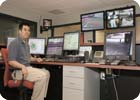
Hosei Maruyama, stadium operations systems administrator at Busch Stadium, St. Louis Mo., where the St. Louis Cardinals play major league baseball, oversaw a security tech update that combined protection and operations needs.
For security at Busch Stadium, it’s bandwidth that’s made a business difference with back-to-back “jacks” of security video and IP communication.
The new Busch Stadium opened in April 2006; but design, development and planning began years earlier. In the early planning phases, Joe Abernathy, vice president of operations, approached me with his concerns about the existing specifications for the video surveillance system, which included VHS recorders. He felt that was an outdated specification.
As a result, we sat down and analyzed what we had and what we needed. The stadium was already slated to be outfitted with an IP infrastructure featuring Cisco switches and fiber connectivity down to the core. So we started asking questions like how much bandwidth would be available, and could we possibly use some of it for the video surveillance system.
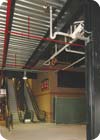
Aimed at escalators, IP cameras provide operations staff with immediate information on crowd needs.
TEAMWORK EFFORT
Once we had our final specifications formulated, the St. Louis Cardinals put the project out for bid. We decided to award the bid to Will Electronics for the materials and integration service, and Sachs Electric Co., which does our electrical work and also installed access control and life-safety systems for the installation of the cameras and equipment. I was the point person to oversee and administer the project, working closely with Ed Heisler from Facility Control Systems.We laid out our security objectives early on and Will Electronics complied with those objectives in the design, and Sachs Electric Co. did the installation.
In the old stadium, 14 cameras had severe limitations on what could be seen. For the new stadium, we had an opportunity to upgrade security surveillance, so we wanted to make sure we took advantage of it. We knew we wanted coverage of the main entry gates, where tickets are scanned. In addition, at the main gates there’s the issue of who’s coming and how fast they’re coming in. We needed to be able to look at that not just from the standpoint of security, but also operationally. One reason – to be able to go back and review movement, to look at what areas were becoming congested so we could determine if we needed to add more ticket takers.
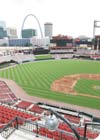
There are a number of vandal proof cameras in the installation such as the IP fixed dome cameras.
And, of course, we need the best surveillance for the seating bowl area, where most of the action happens during events. We need the ability to pan and see any activity going on, because we get all kinds of calls – from people throwing peanut shells onto other fans on different levels to fights breaking out. So those are key areas where we knew we wanted coverage.
Some of the concourse areas are also important, like the first-aid area and escalators. Other stadiums had issues with escalators. We just wanted to make sure we had as many areas as possible covered for the safety of our guests. In addition, the clubhouse area is a sensitive area that needed monitoring. We expanded that over to the visiting clubhouse side and the players’ families’ areas as well, to be sure their families are monitored.
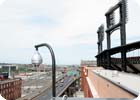
Increased number of cameras at Busch Stadium look outside and inside the facility.
ANALOG, DIGITAL COMBO
The system installed uses a combination of 114 analog and digital cameras from Panasonic, networked together into the existing infrastructure which features Cisco switchers. Since there were four VLANs already established on the network, the camera systems were separated so that they would have their own dedicated portion of that network. While employing the infrastructure already in place, they are controlled by dedicated servers.One decision -- not to integrate with access control and point of sale systems so as to pick the best ingredients of security card access and surveillance. That’s the business philosophy -- not to integrate solely for the sake of integration. The video solution does have the capability to integrate with the Lenel card access system, but the decision at this point is to leave it as a standalone system. One of the other strengths of the security video solution is the recorder is an appliance recorder, a standalone recording unit, so it’s not susceptible to the kind of vulnerabilities of a Microsoft server.
There are a number of vandal proof cameras in the installation. The IP fixed dome cameras that met specifications happened to be vandal proof. That said, we did envision a potential for problems with some of the fans who might have had too much alcohol, or just people getting rowdy. Therefore, we also have a number of perched camera set-ups to prevent anybody with anything in their hands that could have a significant impact on both the view and the connectivity of that camera by impacting or dislodging the wiring.
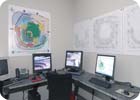
Images captured by the security system can help identify problems in specific areas of the stadium.
SETTING CRITERIA
One other key point in specifying the camera system: image quality. Crowd management is part of the security charge here. In the critical or vulnerable areas of the stadium, we wanted to have an extraordinary picture of where the people are, where they’re coming through, at the gates and the escalators. There are situations where we need to monitor activity, where there might be some people without tickets, or where some people are getting into trouble. In working with a networked infrastructure, a primary part of the selection process was to find a vendor who could seamlessly integrate an IP based mega pixel camera into their solution.The design process was influenced by Ed Heisler from Facility Control Systems, the project consultant. He set out at least 26 design criteria, and vendors like Will Electronics were tapped with providing a solution that met as many of those parameters as possible. With this being a very high profile job, there were a lot of vendors who wanted to quote on this job. In the end, it came down to picture quality, and our final vendor choice was the only one who could supply a solution with mega pixel cameras.
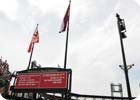
The system uses a combination of 114 analog and digital cameras from Panasonic, networked together into the existing infrastructure, which features Cisco switchers.
SIDEBAR: Inside the Application
In the opinion of Busch Stadium security consultant Ed Heisler, having a technician back focus a camera is the most subjective thing that can be done in a system. It’s in the eye of the technician. But with SDIII technology from Panasonic and auto back focus, you know you’re getting the best possible quality image out of that camera.For the recording solution, Busch Stadium uses a combination of Panasonic digital video recorders and network video recorders. The digital video recorders are used as multiplexers, to create the virtual matrix, not as DVRs. And they’re also there for some redundancy. AXIS Communications encoders on the analog cameras feed the streams into the NVR for recording.
There’s been some talk about potentially integrating the POS system as well. That’s why Busch Stadium wanted to go to an IP-based system, because of the benefits of expanding in the future. With the solution, integration is easier. To the north of Clark Street is the future site of the new Ballpark Village, a mixed-use development project to fill the void left by the old Busch Stadium. With respect to security and surveillance, security may want to have some integration with that once it is developed. The Cardinals Hall of Fame museum and a plaza where fans can gather before and after games are likely to be included in the plans for this project.
According to Hosei Maruyama, stadium operations systems administrator, every other solution he looked at was built in pieces and brought to the table by an integrator. But the major security video vendor had the entire solution. “That was important to us, for a high visibility project like this,” he said.
Looking for a reprint of this article?
From high-res PDFs to custom plaques, order your copy today!






